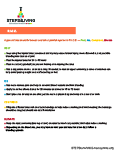Physical Education, Sports, and Recess
Physical activity produces positive physical, psychological, and social benefits for those living with bleeding disorders. It's especially important for preteen and teenage child to participate in sports and physical activity so he or she can gain the skills and knowledge needed to establish and maintain an active lifestyle. Keeping physically fit helps your student with a bleeding disorder maintain a healthy weight and strong muscles—both are important ways to help protect joints. For more information go to the Maintaining a Healthy Body section.
The Section 504 Accommodation Plan and Physical Activity
As you know, the student is entitled to services and accommodations through Section 504 of the Rehabilitation Act of 1973. It is important to remember that under Section 504, students are entitled to receive services and accommodations that allow them to fully participate in all school activities.
School nurses play an important role in creating Section 504 Accommodation Plans for children with bleeding disorders. If parents feel comfortable, encourage them to work with their hemophilia treatment center (HTC) in creating the plan.
The HTC can give you important insight and knowledge about your student's bleeding disorder. Be sure to plan the meeting time so the physical education teacher can attend. This is a crucial meeting for them to hear information and ask questions.
If you or other school personnel are aware of a student's bleeding disorder and know their student does not have a Section 504 Accommodation Plan in place, encourage the parents and student to make one.
Teachers should read the Section 504 Accommodation Plan before the school year begins and throughout the year as a reminder of how to handle a situation or problem if it arises.
Things to remember for those with bleeding disorders:
- Have modified participation in gym and adaptive PE available if necessary.
- Request a schedule of PE activities several days in advance.
- Allow the student to receive PE credits for participating in outside physical therapy.
- Substitute health-related course work for PE credit.
- Have a communication plan in place for the nurse and recess duty aides.
- Consider a permanent pass to the school nurse.
- Consider a permanent pass for the school elevator.
- Have necessary medications, syringes, and supplies locked in the nurse's office.
To download a sample Section 504 Accommodation Plan, go here.
Safeguards and Goals: For Teachers and Nurses
Even if some restrictions or changes must be made, children with bleeding disorders should be able to participate in recess and physical activity classes. Recess is an important part of the school day and it is important that children with bleeding disorders are included in activities. They have a right to take part in PE classes. Even if some limitations or adjustments must be made, he or she can still join in and have fun!
Things to keep in mind during recess:
- Who supervises the playground and recess breaks?
- Is that person aware of your student's bleeding disorder?
- How many classes break at the same time?
- How many supervisors are watching the children at each break?
- Is the play equipment (jungle gym, slide, seesaw, etc) on a soft surface?
- Is any of the equipment broken?
- Is the equipment age-appropriate for the users (separate areas for older kids vs younger ones)?
- What is the recess emergency plan?
For more information visit Maintaining a Healthy Body.
Sports Safety With a Bleeding Disorder
The National Hemophilia Foundation has published Playing It Safe, a brochure that rates the risk of a large range of sports and physical activities. It contains a useful graph to help you and your student decide which activity and sport to join. You will also want to consider the severity and bleeding history of your student and evaluate the risk of bleeding for each activity. Ask parents if their hemophilia treatment center (HTC) team can help make informed decisions about which activities are best.
Here are some modifications to keep in mind:
- Encourage the student to play a position in the sport or game where there is less likelihood of injury. For example, outfielder rather than catcher or shortstop in baseball.
- Make sure they have the right gear to wear for the activity. Most sports require some safety equipment anyway. Ask his or her parents to ask about additional gear (eg, supportive shoes, mouth guards, helmets).
- Pay particular attention to protecting joints with supports such as wrist/knee/elbow guards, tape, and padding.
- Make sure your student does warm up exercises before playing and cool down and stretching exercises after playing.
- In the event of an injury remember: R.I.C.E.
- Rest
- Ice
- Compress
- Elevate
To print out a copy of the R.I.C.E. instructions, click icon:
A student with a bleeding disorder should not:
- Follow the "no pain, no gain" philosophy
- Hide a bleed or injury
- Exercise when in pain
- The child should stop an exercise if it hurts a muscle or joint
- Exercise when healing from an injury
- Injuries should have adequate time to heal
- Stretch too forcefully or bounce at the end of a stretch


